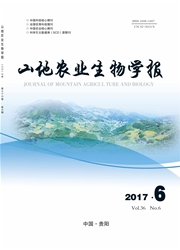

 中文摘要:
中文摘要:
为了解中国始叶螨属的区系特点,本文整理了中国始叶螨属40种的分布信息区系的地理成分,采用区系型单式及复计分析方法分析了其区系特征。结果表明,中国始叶螨属在世界动物地理六界区划中有8种区系型,以东洋界区系为主,比重45.00%;其次为古北界-东洋界跨区区系型,比重22.50%。在世界动物地理十一界区划中有14种区系型,仍以东洋界区系为主,比重30.00%;其次为中日界区系,比重22.50%,跨区区系中以中日界-东洋界跨区区系为主,比重15.00%。在中国动物地理区划中有16种分布型,以华南区区系为主,比重25.00%;其次是华中区区系,比重20.00%。因此认为,中国始叶螨属在世界六界区划中以东洋界区系为主导,与古北界区系间联系紧密,和新北界区系的联系明显;在世界十一界区划中,亦以东洋界区系为主导,与中日界区系和古北界区系间联系紧密,和新北界区系的联系明显。中国始叶螨属在世界十一界区划中国部分中以东洋界区系和中日界区系为主;在中国动物地理区划中华南区区系和华中区区系的重要性相近,华南区区系、华中区区系和华北区区系间的联系密切;中国始叶螨属中国特有种以华南区分布最多,其次是华中区。使用世界十一界动物地理区划能更为全面、详细、明确地解析中国始叶螨属的区系构成和分布特征。
 英文摘要:
英文摘要:
The faunal features of 40 species of the spider mite genus Eotetranychus ( Trombidiformes, Tetranychidae ) from China, based on the distribution records, were analysed usingthe statistic method of every unitary pattern and accu- mulated patterns. The results showed that there were eight unitary distribution patterns in six realms of the World Zoogeo- graphic Divisions. It is clear that Oriental species were in a dominant position at specific level, accounting for 45.00% of the total species, followed by the distribution-type of Palaearctic-Oriental elements, accounting for 22.50%. Based on theview of 11 realms of the World Zoogeographic Divisions, there were 14 unitary distribution patterns. The number of the Oriental species was also the most, accounting for 30.00%, followed by Sino-Japanese species, accounting for 22.50%. The trans-regional faunawas dominantby the Sino-Japanese and Oriental species, accounting for 15.00%. There were 16 unitary distribution patterns in the Chinese Zoogeographic Divisions. Eotetranychus is mainly distributed in the South China region, accounting for 25.00%, then the Central China region, accounting for 20.00%. In conclusion, the faunal features of Chinese Eotetranychus had dominant Orienental elements.The fauna had the closest relationship with the Palaearctic elements and a relative close relationship with the Nearctic regionin the six realms of the Word Zoogeographic Divsions. In the 11 realms of the World Zoogeographic Divsions, the Oriental elements were also dominant, followed by the Sino- Japanese and the Palaearctic elements.The Chinese Eotetranychus showed a discernable relationship to the Nearctic fauna. The faunal features haddominant Oriental elements and the Sino-Japanese elements in the 11 realms of the World Zoogeo- graphic Divisions.Thefauna were dominant byboth the South China Region and the Central China Region elements and had a closer relationship with Northeast Region fauna. Mostendemic species of Chinese Eotetranychus are found inthe South China Region, f
 同期刊论文项目
同期刊论文项目
 同项目期刊论文
同项目期刊论文
 期刊信息
期刊信息
